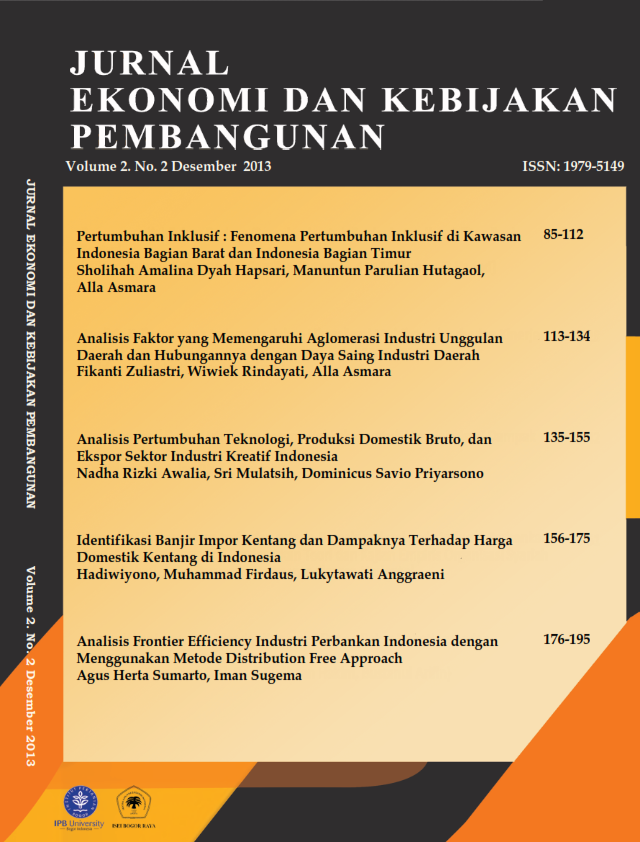PERTUMBUHAN INKLUSIF : FENOMENA PERTUMBUHAN INKLUSIF DI KAWASAN INDONESIA BAGIAN BARAT DAN INDONESIA BAGIAN TIMUR
Abstract
Key words : inclusive, growth, middle class, panel data, excel
References
Ali, Ifzal. 2007. Inequality and the Imperative for Inclusive Growth in Asia. Asian Development Bank.
Ali, Ifzal dan Hyun Hwa Son. 2007. Measuring Inclusive Growth. Asian Development Review Vol. 24, No. 1, pp. 11–31. Manila: ADB.
Ansori, Mohammad Hasan. 2009. Consumerism and the Emergence of a New Middle Class in Globalizing Indonesia. EXPLORATIONS a graduate student journal of southeast asian studies, University of Hawai’i.
Arsyad, Lincolyn. 1999. Pengantar dan Perencanaan Pembangunan Ekonomi Daerah. BPFE : Yogyakarta.
Wie, T.K. 1983. Pembangunan Ekonomi dan Pemerataan, Beberapa Pendekatan Alternatif. LP3ES : Jakarta.
Asian Development Bank. 2010. Key Indicators for Asia and the Pacific. Asian Development Bank : Mandaluyong City, Philippines.
Birdsall, Nancy. 2007. Reflections on the Macro Foundations of the Middle Class in theDeveloping World. Center for Global Development Working Paper 130, Washington DC.
-----------------. 2010. The (Indispensable) Middle Class in Developing Countries; or, The Rich and the Rest, Not the Poor and the Rest. Center for Global Development Working Paper 207, Washington DC.
Habito, Cielito F. 2009. Patterns of Inclusive Growth in Developing Asia:Insights from an Enhanced Growth-Poverty Elasticity Analysis. Asian Development Bank Institute (ADBI) working paper series No. 145, Tokyo.
Ianchovichina, Elena dan Sussana Lundstrom. 2009. Inclusive Growth Analytics Framework and Application. Policy Research Working Paper 4851, The World Bank Economic Policy and Debt DepartmentEconomic Policy Division.
Kakwani, N. dan H. Son. 2008. Poverty Equivalent Growth Rate. Review of Income and Wealth 54(4): 643–655.
Kharas, Homi. 2010. The Emerging Middle Class in Developing Countries. OECD Development Centre, Working Paper No. 285.
Klasen, Stephen. 2010. Measuring and Monitoring Inclusive Growth: Multiple Definitions, Open Questions, and Some Constructive Proposals. ADB Sustainable Development Working Paper Series.
Mankiw, N.G. 2003. Teori Makroekonomi (edisi kelima), Penerbit Erlangga, Jakarta.
McDowell, D. R dan Joyce E. 1995. Poverty Among Southern Workers: Metro and NonMetro Differentials. Journal Agricultural Economic, 77: 796- 802.
Min Tang. 2008. Inclusive Growth and the New Phase of Poverty Reduction in the People’s Republic of China. Asian Development Review, vol. 25, nos. 1 and 2, pp. 81−99.
Őzbudun, Ergun. 2005. The Role of the Middle Class in the Emergence and Consolidation of a Democratic Civil Society. Ankara Law Review Vol.2 No.2 (Winter 2005), pp.95107.
Rusastra, I Wayan. 2011. Reorientasi Paradigma dan Strategi Pengentasan Kemiskinan Dalam Mengatasi Dampak Krisis Ekonomi Global. Pengembangan Inovasi Pertanian 4(2) : 87-102. Pusat Sosial Ekonomi dan Kebijakan Pertanian: Bogor.
Rusastra, I W. and Erwidodo. 1998. Growth, equity and environmental aspect of agricultural development in Indonesia. Forum Penelitian Agro Ekonomi 6(1): 32-41.
Ravallion, Martin. 2010. The Developing World’s Bulging (but Vulnerable) Middle Class. World Development Vol. 38, No. 4, pp. 445–454.
Suryanarayana, M.H. 2008. Inclusive Growth: What is so exclusive about it?. Indira Gandhi Institute of Development Research, Mumbai.
Todaro, Michael. 2000. Pembangunan Ekonomi di Dunia Ketiga, edisi kesembilan terjemahan Munandar, Haris. Bumi Aksara : Jakarta.
Authors

This work is licensed under a Creative Commons Attribution-NonCommercial-ShareAlike 4.0 International License.
The authors who publis article(s) in Jurnal Ekonomi and Kebijakan Pembangunan have to understand and agree that the copyright of article published is owned by Jurnal ekonomi and Kebijakan pembangunan including to reproduce, distribute and sell this journal to public.





